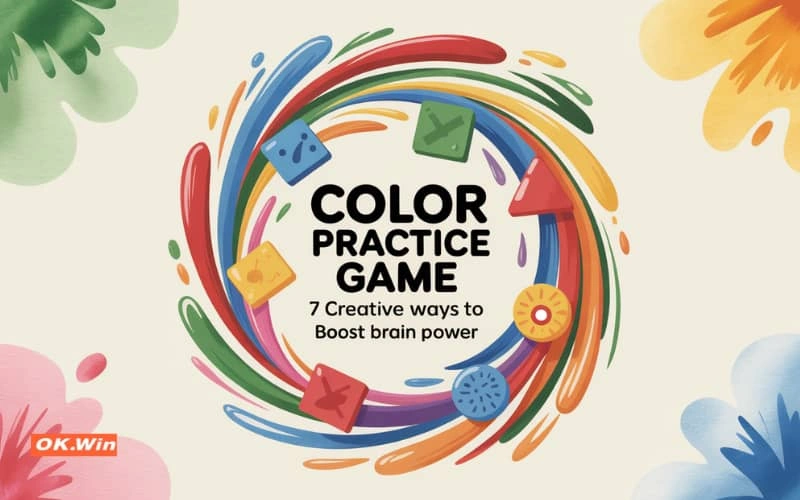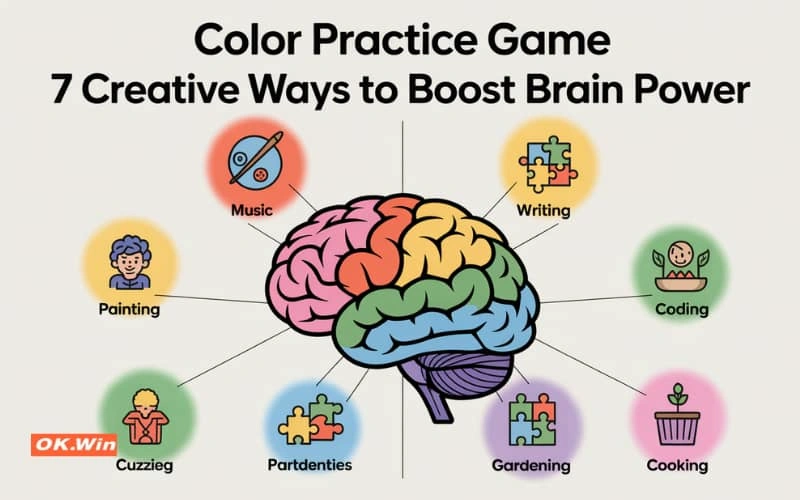The color practice game is more than just a visual activity—it’s a powerful tool to stimulate your brain and improve cognitive performance. Using colors as the core element of play, this game can sharpen your focus, memory, attention span, and problem-solving skills OK Win. With increasing popularity among students, professionals, and brain training enthusiasts, the color practice game offers a fun and engaging way to enhance mental abilities. This guide presents seven creative ways to use the color practice game to boost your brain power and keep your mind sharp.
Improve Focus with Color Matching Challenges
One of the most basic yet effective color practice game methods is color matching. These challenges require players to quickly match identical or complementary colors under a time limit. This fast-paced activity enhances concentration and mental agility. By focusing on finding the correct match within seconds, your brain becomes trained to ignore distractions and respond quickly to visual stimuli. Repeating this exercise regularly increases sustained attention, which is helpful in both academic and professional environments. This version of the color practice game is perfect for players of all ages and can be adjusted for difficulty by increasing the number of color variations.
Strengthen Memory Using Pattern Recall
Another creative use of the color practice game is in memory development. Pattern recall games involve showing a sequence of colored tiles or shapes for a few seconds and then asking the player to repeat the sequence from memory. This strengthens both short-term and working memory, essential components of brain power. The more you practice remembering longer and more complex color patterns, the more you train your brain to retain and process information. This method is particularly useful for students preparing for exams or professionals handling data-heavy tasks. It can also benefit older adults looking to keep their memory sharp.
Enhance Decision-Making Through Speed Tests
Fast color-based decision games are another engaging feature of the color practice game. These tests require players to make snap decisions based on changing color cues. For example, a game may flash a red light that requires a left tap and a green light that requires a right tap. As the pace increases, the player must think and react faster. This boosts both speed and accuracy in decision-making. Such exercises improve cognitive flexibility and mental processing speed, which are crucial for everyday decision-making in high-pressure environments. Regular play can help train your brain to stay calm and responsive under stress.

Increase Visual-Spatial Intelligence with Grid Games
Visual-spatial intelligence refers to the brain’s ability to understand and remember the spatial relationships between objects. The color practice game often includes grid-based puzzles where players must arrange colors in a specific order or identify sequences in a multi-colored matrix. These puzzles force the brain to analyze shapes, positions, and alignments quickly and accurately. As a result, they sharpen your spatial awareness, an important skill in activities like driving, drawing, engineering, and architecture. Practicing this type of color game also improves pattern recognition and logical thinking.
Encourage Creativity through Custom Color Design
The color practice game is not just about logic and memory—it also offers a creative outlet. Many versions of the game allow players to create their own color palettes, themes, or patterns. This stimulates the right hemisphere of the brain, responsible for artistic expression, imagination, and emotional intelligence. Designing your own color sequences or interactive challenges encourages out-of-the-box thinking and supports creative problem-solving. These exercises are great for children in early development stages and also benefit adults working in design, marketing, or innovation-based roles.
Build Emotional Intelligence by Associating Colors with Emotions
Color is deeply tied to human emotion. A unique way to use the color practice game is to train your emotional intelligence by associating different colors with feelings or moods. For example, blue might represent calm, red might signal urgency, and yellow may reflect joy. Some versions of the game use emotion-based scenarios where the player must choose the color that best fits the context. Repeated exposure to emotional cues and their color associations helps players become more aware of feelings and emotional responses. This practice is useful in communication, leadership, and interpersonal relationships.
Train the Brain for Multitasking with Dual Challenges
One of the most advanced ways to use the color practice game is through multitasking challenges. In these games, players must process multiple tasks simultaneously, such as matching colors while solving a math problem or identifying patterns while tracking moving objects. These dual tasks push the brain to divide attention efficiently without sacrificing accuracy. Training your brain in this way improves cognitive load management and enhances productivity in real-world multitasking situations. Professionals who juggle meetings, deadlines, and digital tools can benefit greatly from this brain-boosting method.
Conclusion
The color practice game is a versatile and effective tool for mental development. By incorporating activities such as color matching, pattern recall, speed tests, grid puzzles, custom design, emotion recognition, and multitasking, players can enjoy a well-rounded brain workout. These seven creative approaches help improve focus, memory, decision-making, spatial awareness, creativity, emotional intelligence, and multitasking abilities. Whether you’re using it for education, brain training, or pure fun, the color practice game offers something for everyone. Making it a part of your daily routine can lead to long-term cognitive benefits and a sharper, more adaptable mind.


